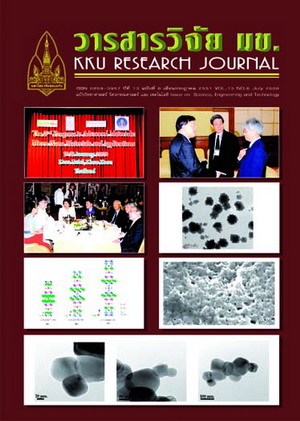Studies on the electronic structures of Bi2Te3 by DX-X alpha method
Main Article Content
Abstract
Electronic structures of Bismuth telluride (Bi2Te3) has been studied by the DV-Xαmethod. In this method based on the self-consistent Hartree-Fock-Slater model, the matrix elements of Hamiltonian and overlap integrals in the secular equation are evaluated by the weight sums of integrand values at the discrete sampling points, instead of conventional integration procedure. The cluster model is Bi8Te13, created by basis data as space group number 166 (R-3m), the lattice parameter, a and c are 4.395 and 30.44, respectively. The cluster was appropriated to the electronic structure. The interatomic distances in the cluster were shown bonding type as covalent and ionic bond between the Bi-Te and Te-Te, Bi-Bi layers, respectively. The cluster was shown molecular orbitals are Te4d, Te5s, Te5p, Bi5d, Bi6s, and Bi6p. The energy levels demonstrated occupied and unoccupied molecular orbitals indicated that energy gap (Eg) of narrow gap as around 0.15 eV. The density of states was evaluated to Fermi energy (EF) on the highest peak of curve as around -0.2 eV
Article Details
How to Cite
Khuangthip, T., Seetawan, T., Kantee, S., & Amornkitbamrung, V. (2017). Studies on the electronic structures of Bi2Te3 by DX-X alpha method. Asia-Pacific Journal of Science and Technology, 13(6), 651–656. retrieved from https://so01.tci-thaijo.org/index.php/APST/article/view/83675
Section
Research Articles
References
-


